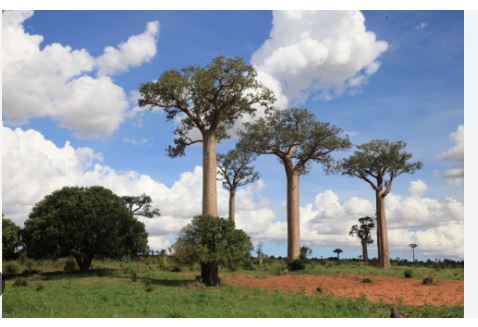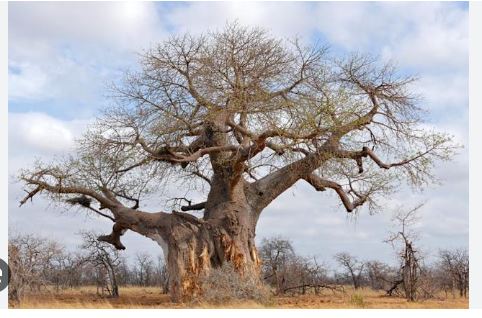
The African baobab (Adansonia digitata), an iconic symbol of the African savanna, is renowned for its massive, water-storing trunk, extraordinary longevity, and cultural significance. Often called the “Tree of Life,” this deciduous giant supports entire ecosystems, providing food, water, shelter, and medicinal resources for humans and wildlife. Native to sub-Saharan Africa and parts of the southern Arabian Peninsula, A. digitata is the most widespread species of the Adansonia genus, thriving in hot, dry savannas where few other trees survive. While the Adansonia genus includes nine species, with six endemic to Madagascar, one to Australia, and two in Africa, A. digitata exhibits remarkable regional diversity across its range, with variations in fruit shape, trunk morphology, and genetic profiles.
Why African Baobab Variants Are a Natural Wonder
African baobabs are pachycauls, characterized by swollen, water-storing trunks that can reach 30 feet in diameter and 82 feet in height, making them some of the largest and longest-lived flowering plants, with some specimens exceeding 2,000 years. Their palmately compound leaves, white nocturnal flowers, and nutrient-rich fruit support diverse wildlife, from bats to elephants, while humans use every part—fruit pulp, seeds, leaves, bark, and roots—for food, medicine, and materials. Genetic and morphological variations across Africa, such as elongated fruits in Angola or compact crowns in Sudan, suggest regional adaptations, though A. digitata remains a single species, with the proposed A. kilima now considered a synonym. Thriving in USDA zones 10b–12, baobabs tolerate extreme drought and fire, regenerating bark even after severe damage.

African Baobab Trees
1. Senegalese Coastal Baobab
Found along Senegal’s coast, particularly near Dakar and the island of Sor, this variant is historically significant, with trees like the Gouye Ndiouly (Guy Njulli) linked to royal ceremonies since the 16th century. Growing 50–80 feet tall with massive, cylindrical trunks up to 25 feet in diameter, these baobabs have smooth, pinkish-gray bark and rounded fruit with high vitamin C content. Their leaves, with 5–7 leaflets, are used as a spinach-like vegetable. Thriving in sandy, well-drained soils, they tolerate salty coastal conditions and store vast water reserves, supporting communities during droughts. Plant with deep taproots for stability and pair with millet for agroforestry. This variant is ideal for West African growers seeking a culturally rich, drought-resistant tree.
2. Sudanese Savanna Baobab
Dominating Sudan’s Darfur and Kordofan regions, this variant grows as solitary giants in arid savannas, reaching 60–82 feet with broad, irregular crowns. Its fruit is typically ovoid, with a woody shell and powdery pulp used for beverages. The bark, often stripped by livestock, regenerates rapidly, and hollow trunks host beehives, producing premium honey. Adapted to low rainfall (10–20 inches annually), it prefers loamy soils and full sun. Its seeds, rich in protein and oil, are roasted or pressed for cosmetics. Pair with acacia for savanna restoration. This variant suits East African growers in semi-arid zones wanting a resilient, multipurpose tree.
3. Angolan Elongated-Fruit Baobab
In Angola’s savannas, this variant is distinguished by its elongated, cylindrical fruit, unlike the rounded or ovoid fruits elsewhere. Growing 40–70 feet with fluted, buttressed trunks, it has a warty, gray bark texture and sparse canopies. The fruit pulp, high in tartaric acid, is used for refreshing drinks, while leaves treat malaria in traditional medicine. Thriving in rocky, well-drained soils, it tolerates high temperatures but needs protection from waterlogging. Plant in clusters for pollination by bats. This variant is perfect for southern African growers seeking unique fruit for local markets.
4. Tanzanian Highland Baobab
Found in Tanzania’s high-elevation sites (above 3,000 feet), this variant exhibits compact crowns and smaller, rounded fruits, possibly due to cooler climates. Growing 50–75 feet with multiple fused stems, it has smoother, reddish-brown bark and 5–9 leaflet leaves. Its fruit pulp is processed into jams, and seeds are ground for coffee-like drinks. Adapted to rocky, shallow soils, it requires full sun and minimal water. Pair with maize for agroforestry systems. This variant is ideal for East African growers in upland areas wanting a hardy, productive baobab.
5. Namibian Ancient Baobab
Exemplified by specimens like the 1,275-year-old Grootboom, this Namibian variant is among the oldest, growing 60–80 feet with massive, hollow trunks up to 30 feet in diameter. Its fruit, rich in antioxidants, supports local diets, while bark is woven into ropes. Thriving in arid, sandy soils, it stores thousands of gallons of water, surviving extreme droughts. Its open canopy suits savanna wildlife habitats. Plant with deep mulch to mimic natural conditions. This variant is perfect for southern African growers seeking a legacy tree for conservation.
6. South African Hollow Baobab
In South Africa’s Limpopo region, this variant features supersized, hollow trunks used historically as shelters, prisons, or pubs, like the Sunland Baobab. Growing 70–82 feet with girths up to 155 feet, it has coppery bark and rounded fruit used for porridge. Its leaves are boiled for kidney remedies. Thriving in frost-free, loamy soils, it regenerates after elephant damage. Pair with grasses for erosion control. This variant suits growers in protected areas wanting a tourist-attracting, multifunctional tree.
7. Malian Arid Baobab
Common in Mali’s Sahel region, this variant grows 50–70 feet with cylindrical, water-storing trunks and sparse, rounded crowns. Its fruit, high in calcium, is a famine food, while leaves treat asthma in local remedies. Adapted to sandy, low-nutrient soils, it tolerates intense heat and long dry seasons. Its bark supports rope-making. Plant with sorghum for intercropping. This variant is ideal for West African growers in arid zones seeking a survival crop with commercial potential.
8. Kenyan Clustered Baobab
In Kenya’s semi-arid regions, like Tsavo, this variant grows in dense clusters, reaching 60–80 feet with fluted, gray trunks. Its ovoid fruit is used for juices, and seeds yield oil for cosmetics. The leaves, rich in iron, are a dietary staple. Thriving in rocky, well-drained soils, it supports bat pollination and bee hives. Pair with sisal for agroforestry. This variant is perfect for East African growers wanting a high-density, income-generating baobab.
9. Zimbabwean Panke Baobab
Named after the 2,450-year-old Panke baobab, this Zimbabwean variant grows 60–80 feet with massive, buttressed trunks and irregular branches. Its fruit pulp is a superfood, and bark is used for mats. Adapted to hot, dry savannas with loamy soils, it resists fire and termites. Its hollows shelter wildlife like bushbabies. Plant in open savannas for natural regeneration. This variant suits southern African growers seeking a historic, ecosystem-supporting tree.
10. Ethiopian Baobab
Found in Ethiopia’s dry lowlands, this variant grows 50–75 feet with smooth, purplish-gray bark and rounded fruit used for beverages. Its leaves treat insect bites, and seeds are roasted for snacks. Thriving in sandy, well-drained soils, it tolerates drought but needs frost protection. Its open canopy supports bird nesting. Pair with teff for agroforestry. This variant is ideal for East African growers in arid zones wanting a versatile, edible tree.
11. Mozambican Coastal Baobab
Along Mozambique’s coast, this variant grows 60–80 feet with cylindrical, smooth trunks and ovoid fruit high in potassium. Its leaves are used for soups, and bark for cloth. Adapted to sandy, saline soils, it tolerates coastal flooding but needs full sun. Its fruit supports local markets. Plant with cashew for intercropping. This variant suits southern African growers in coastal areas seeking a resilient, marketable tree.
12. Omani Introduced Baobab
Introduced to Oman’s southern coast, this variant descends from African stock, growing 50–70 feet with smaller, rounded fruit and reddish bark. Its pulp is used for drinks, and leaves for fodder. Thriving in well-drained, sandy soils, it adapts to arid, frost-free climates. Its compact crown suits urban planting. Pair with date palms for agroforestry. This variant is perfect for Middle Eastern growers seeking an exotic, multipurpose tree.